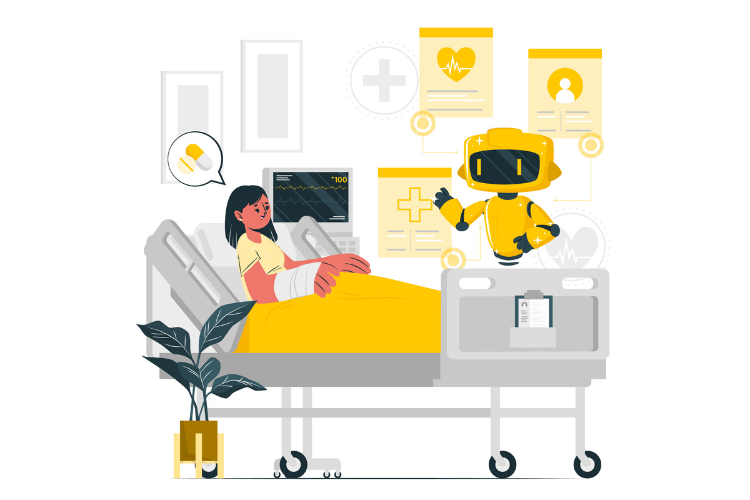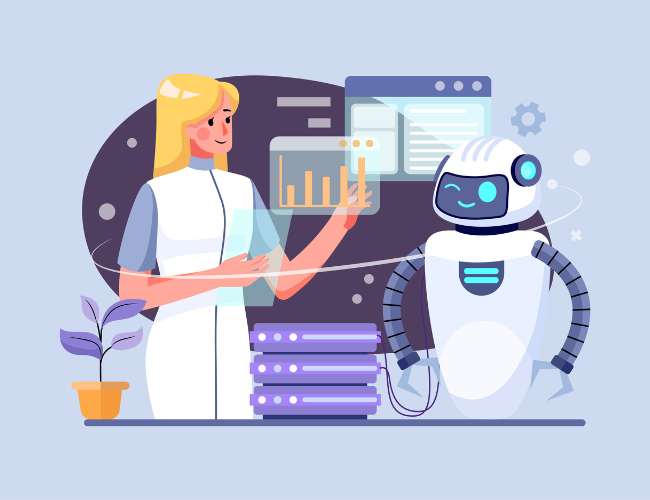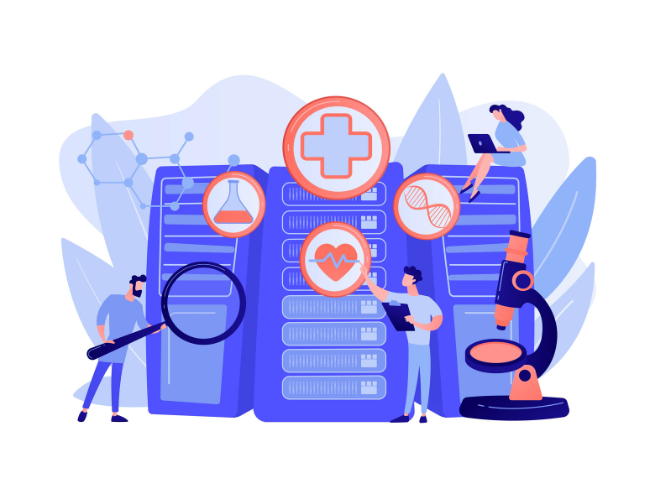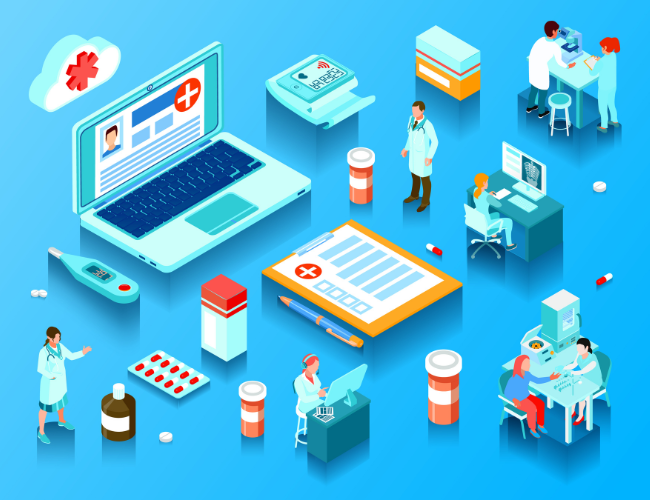Building solutions that leverage AI in healthcare-related operations is a complex endeavor, but the benefits received in return make the effort worthwhile. If you’re interested in understanding the concepts, benefits, limitations, and the proper methods of building an AI-enabled healthcare solution, this blog is tailor-made for you!
While previously the applications of AI in healthcare were limited to primarily optimizing the administrative tasks within a healthcare organization. The use cases now have expanded towards covering some of the more “hands-on” operations. While the concepts have been around for a long time, satisfying accuracy and consistent results were difficult to obtain for these medical procedures, especially because of the industry’s high-stakes nature. However, with enough training and new iterations of these AI models, the current performance has reached an impressive position.
Speaking of impressive, the healthcare market has also been growing quite promisingly, recorded at a market value of US$ 19.54 billion back in 2023, the AI market in the healthcare industry has been growing at a dramatic 43.2% CAGR and is on track to become a US$ 490.96 billion market by 2032 (Source: Fortune Business Insights). All thanks to the progress AI has made as a technology, leading to the emergence of so many technologies. But before we get into the nitty-gritty of what makes AI in healthcare such a sweet deal, let’s start from the very basics of what AI in Healthcare truly represents.
Get Complementary Healthcare App Consultation!
What is AI in Healthcare?
For starters, AI in healthcare represents the implementation of various AI technologies like NLP, computer vision, machine learning, etc, to enhance the efficiency of both simple and complex medical procedures, all while maintaining consistent and reliable outcomes.
The implementation of medical AI aims to streamline multiple individual tasks that can be categorized under 4 primary objectives –

[1] Optimizing the Patient’s Experience
AI helps to enhance a patient’s experience by introducing upgrades like Electronic Health Reports (EHRs), insurance assistance tools, and virtual assistance apps. These apps understand the patient’s issues and respond with relevant information. Tools like EHR can store and extract information regarding the patient’s healthcare history for – the doctors to analyze, or, insurance claim companies to validate and provide a smooth claim procedure.

[2] Providing Assistance to the Healthcare Professionals
Medical professionals attend to an enormous number of patients every day, and it gets worse in areas with a deficit of doctors in comparison to the population. AI solutions aim to help these medical professionals by providing all the necessary tools for diagnosis as swiftly as possible. AI-backed medical diagnoses allow doctors to attend to more patients each day to somewhat tackle this non-favoring ratio.

[3] Managing Paperwork and Inventory-Related Tasks
Various AI technologies collectively automate a significant chunk of the administrative and bookkeeping operations within a medical establishment. Tasks like – filling out a form, deciphering prescriptions, keeping track of inventory, and much more can be automated with the use of AI, further enhancing the medical cycles.

[4] Research and Drug Discovery
Besides enhancing the patient journey and associated operations, the use of artificial intelligence in healthcare is also well known for enhancing the rate at which medical research is conducted. It speeds up the various testing iterations by predicting the outcomes, in case a sufficient amount of relevant data is available.
Advantages of using AI in Healthcare
So far, we have discussed the ways in which the partnership between AI and healthcare adds value on top of the traditional medical practices. However, the exact method behind how it is made possible still needs discussion. Let’s go through that now!

[A] Early Detection
Machine learning-based AI models can be constantly trained using archived and new reports. First, the personal information is removed for privacy. Later, the symptoms are mapped with the diagnosed issues. The intent here is to train the AI model to allow analysis and pattern identification between the symptoms and the issues. Once that information is extracted, it can be used to identify the possible issues more accurately and with fewer tests.
When this model is used on a new patient, and the observable symptoms are fed to the medical AI model, it can predict the presence of an underlying issue based on the historical data present. Medical professionals can refer to these possibilities and prescribe relevant tests. The reports will either clear off the possibilities or detect the issues at a very nascent stage.

[B] Vaccination and Other Research
Simply put, AI can go through millions of possible combinations to find out the most optimal medical composition or antigens that generate the desired response from the test subject. Further, it assists during the testing phase of a newly discovered vaccine by shortlisting the best possible candidates to perform the test upon, along with analyzing the data to generate insights.
Traditionally, researchers had to develop thousands and thousands of pre-clinical samples to produce a single vaccine that could be approved for human implementations. The process in itself would take decades on an average which is catastrophic in case of a life-threatening outbreak. Not to mention the hundreds of millions needed for the development. (Source: PWC)
With the introduction of AI to this procedure, the goal is to bring the development cost and time down, mitigating a major chunk of the impact.

[C] Diagnosis
We briefly discussed the benefits of using AI medical diagnosis concerning early issue detection, but that’s simply a small section of AI’s complete diagnosis capabilities. Doctors leverage AI to perform several additional diagnosis operations, including –
1. Image Analysis: Visual medical reports like X-rays or Ultrasounds often have several insights, some of which could be missed if analyzed manually, this is where AI technologies like computer vision are leveraged to yield more accurate results.
2. Medical History Summarization: Medical reports can be extensive, and a lot of the information might not be relevant to the ongoing diagnosis. An NLP-enabled AI model trained to summarize medical reports & highlight relevant information for the ongoing diagnosis area can come in very handy in such scenarios.
3. Remote Diagnosis: Telemedicine applications have become a convenient option to diagnose normal symptoms remotely and prescribe medicines for the same without any need for a physical appointment.

[D] Treatment Support
If you thought AI was simply assisting with the monitoring and analysis-focused tasks with no contribution to the actual treatment, you would be wrong. The use of AI medical robots has observed some dramatic improvements in the last few years.
Using an extensive roster of AI-based technologies like computer vision, deep learning, RPA, and machine learning in healthcare, enables bots to – assist doctors across laboratory testing and surgical procedures, or, to perform entire surgeries by themselves with the supervision of a healthcare professional.
Post-procedure mandates like observing vitals and therapy sessions also observe a significant contribution from AI-enabled machinery.

[E] Optimal Data Storage and Extraction
The total medical data available globally is vast and unorganized for the most part. Making it impossible to gain insights from it using traditional data analysis/extraction methods. AI comes in clutch here to provide an efficient way to scour through vast databases within seconds to extract the necessary information.
Furthermore, the implementation of AI in healthcare also prompts the restructuring of the scattered datasets to streamline the information. The most accurate example would be the use of EHRs we briefly mentioned. It stores the patient’s details in a structured format, which is then stored in the database with the necessary labels. This data can be used to directly gain the patient’s information, or can be used for analytics using these labels.
Current Limitations of Using AI in Healthcare
Although medical AI has taken some gigantic leaps to improve its proficiency, there are still some areas that need further refining, including –

[i] Data Privacy
Organizations have historically been caught notoriously asking for more information than necessary for the sake of data analytics and surveys. This stands as a direct violation of the patient’s privacy. AI models might be at risk of following these footsteps, which is why regulatory compliances like HIPAA and GDPR have been a compulsion across medical applications across the US and the UK.

[ii] Bias
For an AI medical diagnosis to be accurate and reliable, it is crucial to train the data using an unbiased dataset with an equal distribution of entries across all possible outcomes. Easier said than done, in most cases if the medical organization is using their personal data, there will inevitably be a certain level of bias given the information will be limited to either a specific demography, age group, or ethnicity (maybe all of the above).

[iii] Misinformation & Reliability Concerns
It is a byproduct of the previous point. Not using proper datasets of training leads to the model providing inaccurate results and prescribing inaccurate medications. This can cost the medical organization a major setback, thus the issue should be acknowledged and resolved immediately.
To prevent these issues from ever touching your AI model, you’ll need to avail healthcare-specific AI development services from a team of experts who understand the intricacies of building a reliable and just AI model.
How to Create a Medical AI Solution
With the many merits and a few demerits out of the way, it is time to discuss how AI in healthcare is truly implemented. The inception of the journey needs an idea and a reliable healthcare-focused software development partner under your belt. With that covered, the development journey can officially begin –

[a] Planning
Once you have your basics accounted for, it is time to lay the foundations by mapping the primary pain points of the healthcare organization and the related features being built in the AI model to fix those issues. The aim is to brainstorm and collect every single use case necessary, including the modules and the integrations to basically scope and bind the entire project, mitigating the changes of any surprise work creeping in that may influence, or rather inflate, the development costs.
Once the brainstorming is completed, a BRD is generated along with a quote that is agreed upon by the clients and the development team. This BRD is adhered to until the end of the project and is a representation of the agreement between the two parties.

[b] Design and Development
For designing a healthcare solution, it is essential to keep into account the entire user base of the AI model and the associated application it aims to serve. The application’s UI should resonate with these values. Being intuitive and simple, with a very organized look and a straightforward user journey, has to be the basics of the software’s designing phase.
Next up comes the development of the AI model and the corresponding user application. The back-end and the API structure are built according to the BRD and the progress is well documented by the developers for future reference. Relevant security measures are also implemented to ensure the user data is secured and not vulnerable to any external attacks.

[c] Testing and Success Rate Analysis
Once the development is completed, the model is initially tested by the developers and then handed over to the quality analysts (QAs). They test the application extensively from a technological standpoint, if an issue is detected, a ticket is raised for the development team. The development team identifies the issue and resolves it for the QAs to test once again. A typical software development cycle will complete the development cycle at this point or might go for alpha or beta phases directly.
However, testing a healthcare AI model needs to prove itself on the clinical level as well. Once the application clears all the functionality checkboxes, it is tested on a significant sample of patients to check its reliability and accuracy. If the model generates satisfying results, it is sent to the next phase. If it fails to do so, it is sent for another cycle of brainstorming and improvement.

[d] Monitor and Maintain the Cloud Infrastructure
After the clinical testing approval, the application is pretty much deployed to the end users as soon as possible. From the development standpoint, this marks the end of the cycle, however, the development team is still kept in the loop for any post-migration issues that may emerge.
The developers are typically offered a small percentage of the project cost annually to perform scheduled maintenance checks and to be available on cue in case any architectural or other issue disrupts the application's ideal flow.

[e] Scale Up Whenever Necessary
The foundations for this step are laid from the very beginning of the development phase, almost every AI model is built to process the requirements of a certain scale initially, hoping to expand its capacity as and when the demand increases. And the healthcare AI models are no different.
Cloud infrastructure has made scaling significantly easier for developers as they always have the option to purchase more computing power and leverage it to address the demands of a higher number of users. The cloud computing services typically provide the option to scale both vertically and horizontally. Where horizontal scaling means increasing the number of servers and vertical scaling means increasing the computing power of the existing servers.
Future of AI in Healthcare
AI has been a frontrunner for innovations and opportunities in the healthcare industry, starting from automated transcription to image analysis and early disease detection. However, experts claim this to be just a taste of AI’s full potential.
As the technology evolves, the use cases of AI in healthcare will see a massive spike from its current standing. The concepts of AI participating in the more “hands-on” tasks are currently being worked upon and the clinical trials for a few have already begun.
All in all, from a technological standpoint, the future of medical AI is bright. With time, it is expected to replicate human traits more effectively and integrate empathy, reasoning, and consequences in its decision-making variables.
The primary, however, when it comes to the future of AI will be the commercialization of the new technologies to reach the global population in resourceful ways, and assisting these technologies with the ongoing medical practices without demanding a complete 180° turnaround.
Conclusion
We’ve pretty much covered all the talking points that are essential to understanding the trade-offs and proper implementation of AI in a healthcare organization. And it’s pretty much clear that AI and healthcare have a flourishing partnership that is only going to improve in the years to come.
Given that you’ve stuck for this long, chances are that you’re someone who has a vision to disrupt this industry with a product or you simply wish to optimize your medical organization’s day-to-day operations. Whatever the requirement might be, you’re going to need a development team experienced in the healthcare industry to back you up on that project. That’s where we come in.
We’ve built custom software solutions for businesses across the world covering various industries including multiple healthcare-centric projects. The testament of our product quality is greatly reflected in our 94% repeat customer rate! Want to be a part of our satisfied partners? Let’s start talking!
FAQs
The main AI technologies used in healthcare as of now and their applications fall under:
- 1. Machine Learning – Medical pattern recognition, research assistance, etc.
- 2. Computer Vision – Medical report analysis, symptom detection, etc.
- 3. Natural Language Processing – Medical transcription, EHR summarization, etc.
The main objective behind the development of AI models is not to replace doctors, it’s rather to help them perform their tasks more efficiently and with greater accuracy. Currently, there is a global deficit of doctors and other medical professionals, so it is almost impossible for AI to take away the jobs of any employee related to the medical industry.
Well, except for the ones that are not willing to learn how to leverage AI to enhance their overall efficiency.
AI has been under clinical trials to assist human surgeons with procedures and is showing some promising performance while doing so. However, AI models performing surgeries independently still seem to be a long shot. Researchers have been working on approvals for a few AI models that are performing non-invasive surgeries like biopsies or ablations, but constant supervision by an actual healthcare professional is recommended at all times.
Various companies are competing to enhance the doctor’s experience while performing their responsibilities by building tools encompassing various use cases such as –
- 1. Medical Image Analysis Tools: ENDEX, Viz.ai, ButterflyNetwork, etc.
- 2. EHR Tools: Epic Systems, Cerner, NextGen Healthcare, etc.
- 3. Clinical Decision Assistance Tools: IBM Watson, Optum, Health Catalyst, etc.
- 4. NLP Tools: Abridge, Nuance Dragon, Suki, etc.





.png)
.png)

